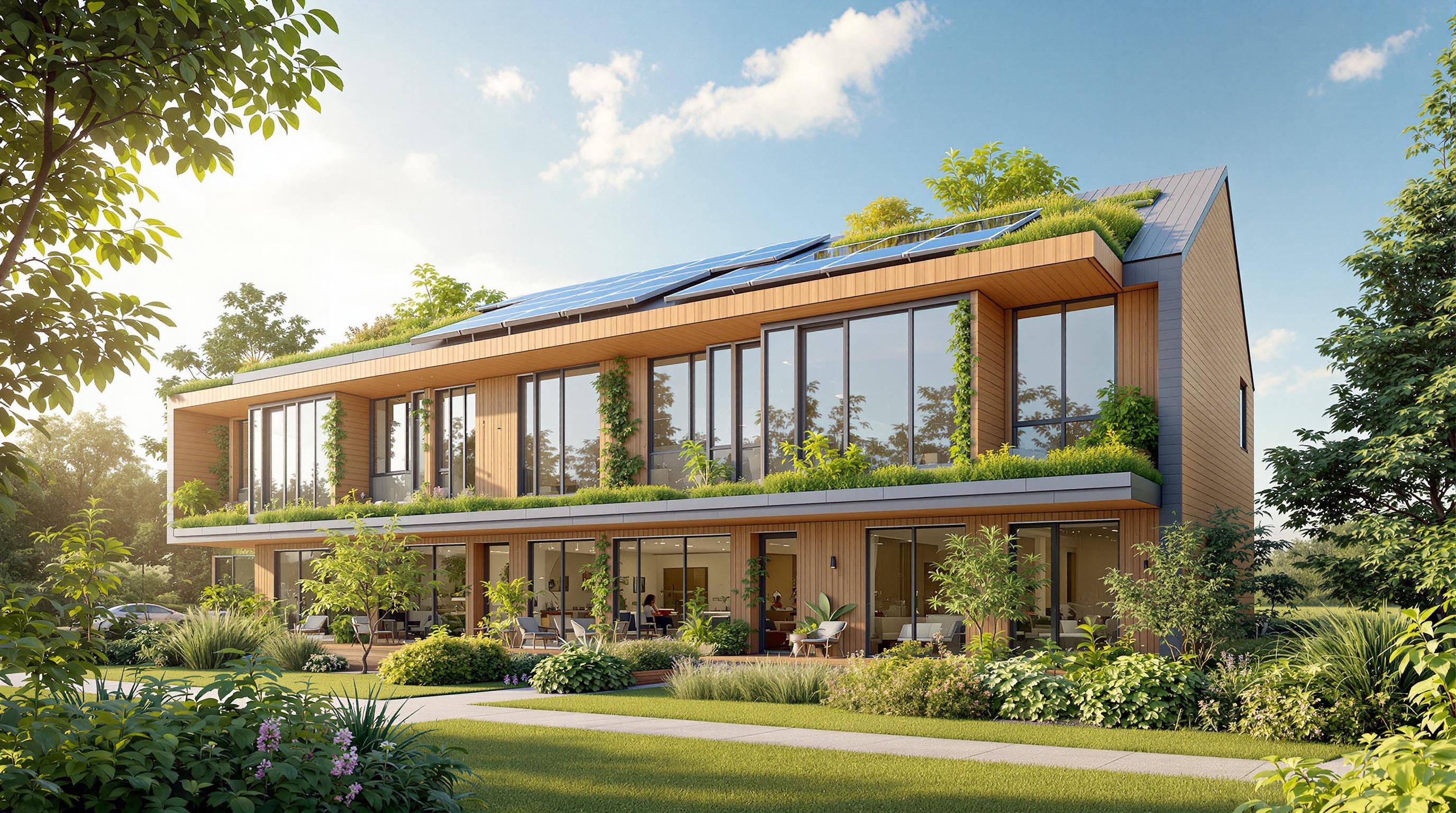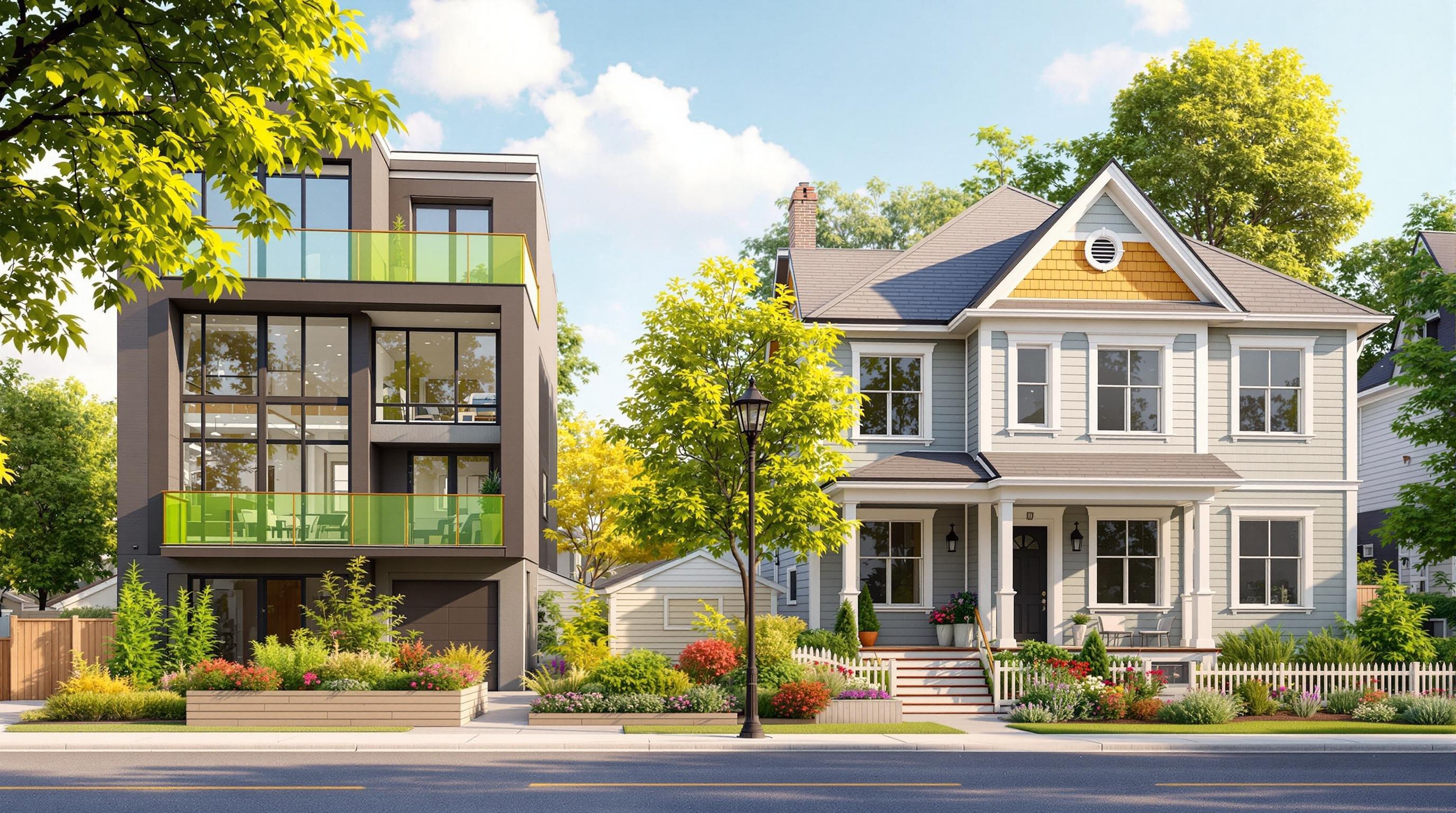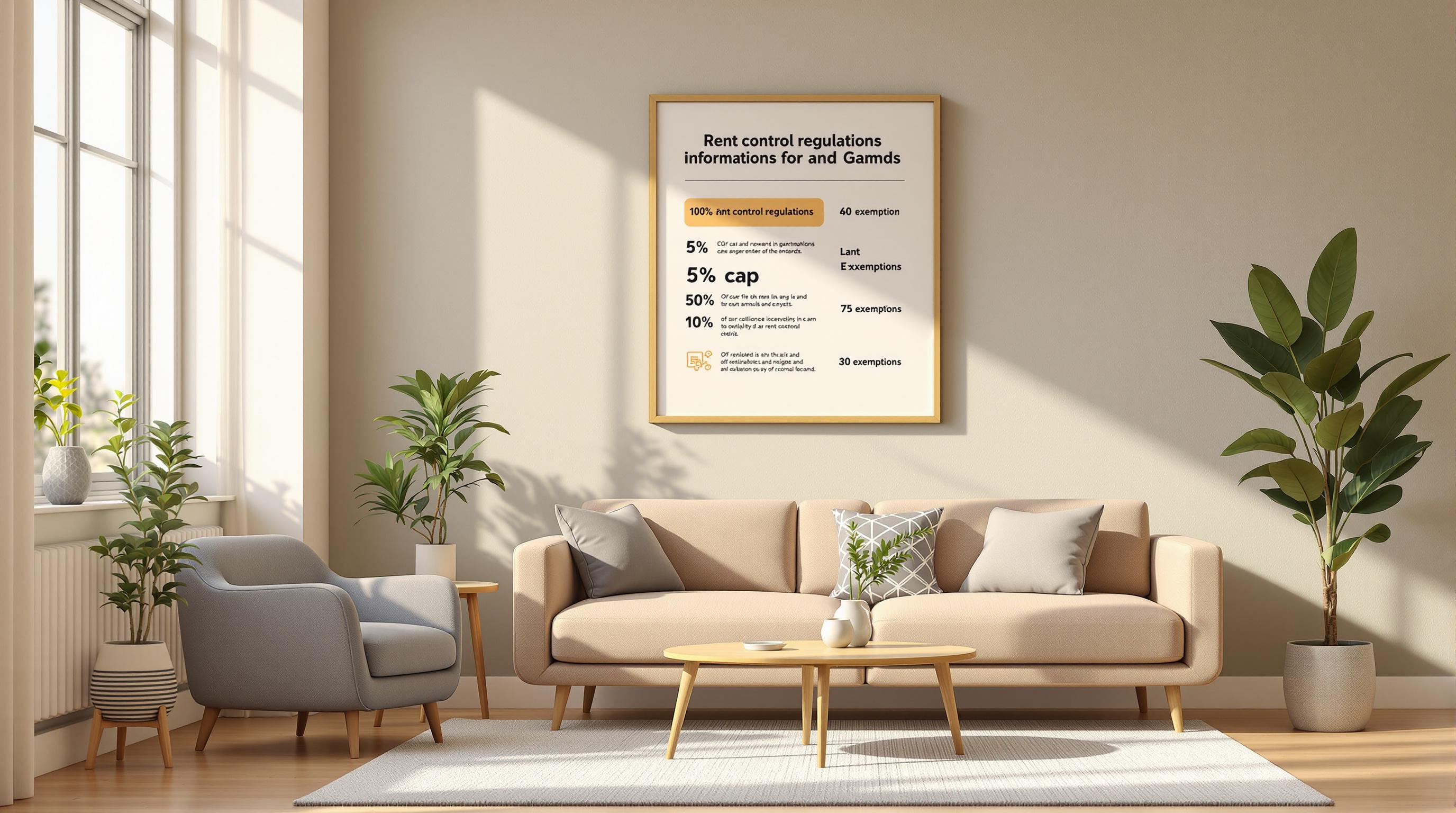Want to boost rental income from your multi-unit property in Nova Scotia? Here’s how you can make the most of a competitive market like Halifax, where vacancy rates are as low as 1.0%. From smart renovations to using tax benefits, these 7 strategies can improve your ROI by 8–12%:
- Upgrade properties: Focus on kitchens, bathrooms, and energy-efficient features to attract tenants and justify higher rents.
- Optimize layouts: Use open-concept designs and maximize small spaces to increase rental value.
- Understand zoning laws: Take advantage of Halifax’s zoning changes to add legal units or expand properties.
- Streamline property management: Use digital tools and tenant retention strategies to maintain steady income.
- Cut energy costs: Leverage Nova Scotia’s energy rebates for heat pumps, solar panels, and insulation upgrades.
- Explore short-term rentals: Tap into Nova Scotia’s growing tourism market for higher earnings.
- Use tax incentives: Claim deductions and access forgivable loans for secondary suite projects.
What Tenants ACTUALLY Look For in Halifax Rental Properties
1. Smart Property Upgrades
Making thoughtful property improvements in Nova Scotia can increase rental income by justifying higher rents and attracting reliable, long-term tenants. Here are the upgrades that tend to offer the best returns.
Renovations That Pay Off
Kitchen and bathroom renovations often provide a 70–80% return on investment [3]. To get the most out of these updates, focus on these key areas:
- Kitchen Updates
- Bathroom Modernization
- High-Impact Amenities
These upgrades not only make your property more appealing but can also lower operating costs. Savings on utilities and higher rental rates can yield returns of 50–75% [3]. Combining multiple improvements at once can amplify the benefits while keeping renovation disruptions to a minimum.
2. Better Unit Design
Improving unit design can directly boost rental income in Nova Scotia's competitive market by attracting tenants willing to pay higher rents.
Space Planning for Higher Income
Modern layouts that balance style and functionality can increase rental value while keeping the charm of Nova Scotia's properties intact.
In urban areas like Halifax and Dartmouth, open-concept designs can lead to rent increases of up to 15% [1]. Some effective layout upgrades include:
- Turning unused corners into built-in office spaces
- Adding custom closets for better vertical storage
- Enlarging windows to bring in more natural light
- Creating versatile spaces for dining or work
Open layouts work well for larger units, but even smaller spaces can be optimized for better returns.
Maximizing Small Spaces
Smaller units can benefit from smart design tweaks that increase appeal without requiring major renovations.
Visual Space Improvements:
- Use high curtain rods that extend beyond the window frame
- Place mirrors strategically and choose light-colored paint to brighten rooms
- Add built-in shelves to utilize vertical space
Functional Storage Solutions:
- Install murphy beds in studios
- Add pull-out pantry systems for extra kitchen storage
- Use the space under stairs for hidden storage in multi-level units
Pair these upgrades with practical amenities like parking, in-unit laundry, and smart home features to attract tenants willing to pay more.
3. Zoning and Building Rules
If you're looking to boost rental income by adding legal units to your property in Nova Scotia, understanding zoning regulations is a must. Halifax's recent zoning changes have created new opportunities for property investors to expand their portfolios.
Legal Unit Addition Process
Halifax's Centre Plan has simplified the process for adding legal rental units by introducing three zoning categories that shape multi-unit development:
| Zone Type | Permitted Units | Additional Features |
|---|---|---|
| ER1 | Secondary suites and backyard suites | Three-unit conversions in select areas |
| ER2 | Up to 4 connected townhomes | Two- and three-unit dwellings allowed |
| ER3 | Up to 8 connected townhomes | Four-unit apartments and ground-floor commercial uses |
Here’s how property owners can legally add rental units:
- Check the zoning: Use Halifax's web portal to confirm your property's zoning designation.
- Review allowable uses: Make sure the unit types and density you want are permitted under the zoning rules.
- Submit a development application: Provide detailed plans that meet current building codes.
- Get permits: Secure all necessary permits before starting construction.
For example, Helio Urban Development offers duplex builds starting at $175 per square foot, making it easier to navigate these steps and tap into the region's growth.
Finding Growth Zones
Zoning changes aren't just about compliance - they also reveal where the best investment opportunities lie. With Halifax facing a housing deficit of nearly 18,000 units [5], the city plans to add 15,000 new units over the next three years [5] through targeted rezoning.
Some high-potential areas include:
- Transit corridors: Zones that now allow buildings up to 7–9 stories.
- University-adjacent areas: HR-2 zones permitting construction of up to 9 stories.
- Neighborhoods with city infrastructure: Areas with water and wastewater systems, where at least 4 units are allowed.
Recent approvals show the potential. For instance, in August 2024, the Southdale-Mount Hope SPA received the green light for 875 residential units, including multi-unit buildings and townhomes [4].
"It is a transformational opportunity to drive housing in our community" – Jacqueline Hamilton, Halifax's executive director of planning and development [5]
Investors should prioritize areas undergoing upzoning, especially those shifting from single-family zones to ER-2 and ER-3. These zones offer more flexibility for multi-unit projects and better rental income opportunities.
sbb-itb-16b8a48
4. Property Management Methods
Effective property management plays a crucial role in boosting rental returns, especially in Nova Scotia's competitive rental market.
Tenant Selection and Retention
Securing dependable tenants is essential for maintaining consistent income. Careful tenant screening helps ensure long-term occupancy and lowers turnover rates [6].
Here are some strategies to keep tenants happy and encourage them to stay:
| Strategy | How It Works | Benefits |
|---|---|---|
| Regular Maintenance | Conduct routine inspections and timely repairs | Prevents emergencies and keeps tenants satisfied |
| Flexible Lease Options | Provide incentives for early renewals | Builds tenant loyalty and reduces vacancies |
| Competitive Rent Rates | Price units slightly below market average | Attracts quality tenants and maintains high occupancy |
| Community Engagement | Create shared spaces and host tenant events | Strengthens relationships and improves retention |
Addressing maintenance issues quickly and offering flexible lease terms can go a long way in keeping tenants satisfied [8]. Adding digital tools to these traditional methods can make property management even more efficient.
Digital Management Tools
Using technology can simplify property management and improve tenant satisfaction. For example, Motili’s asset management system increased tenant satisfaction by 20% by proactively managing HVAC and hot water systems [7].
"We're able to give a true forecast a few years out and look at not just one or two buildings but across the nationwide portfolio, helping a multi-family conglomerate find tens of millions of dollars through savings and optimization. It often makes more sense to spread your investment over a multi-year period." - Matthew Sallee, Motili Vice President [7]
Some useful digital tools include:
- Automated maintenance tracking
- Online rent payment systems
- Digital lease management platforms
- Tenant communication portals
These tools can streamline operations and help property managers stay on top of their responsibilities while improving the tenant experience.
5. Energy Cost Reduction
Rising energy costs can take a big bite out of profits. Nova Scotia offers various rebates and incentives to help property owners cut expenses while increasing property value. By combining these programs with smart management strategies, you can significantly improve your bottom line.
Nova Scotia Energy Rebates
Efficiency Nova Scotia provides programs designed to lower energy costs for multi-unit properties. Here's a quick look at the available rebates:
| Program Component | Rebate Amount | Eligibility |
|---|---|---|
| Heat Pump Installation | Up to $2,500 | Multi-unit residential properties |
| Solar PV Systems | $0.60 per watt | Residential properties |
| Low-Income Property Upgrades | Up to 80% | Eligible multi-unit properties |
| Non-Profit Property Upgrades | Up to 100% | Registered non-profits |
These rebates can be accessed through the Your Energy Rebate Program (YERP), which covers residential and partly residential condominium properties [9]. Efficiency Nova Scotia's initiatives have already helped property owners save a combined $1.99 billion on energy bills [10]. Considering that buildings are responsible for 18% of Canada's greenhouse gas emissions [12], and space heating alone accounts for over 60% of energy use in the average Canadian home [11], these programs are a win-win for both your wallet and the environment.
High-Return Energy Updates
For multi-unit properties, focusing on major energy consumers like heating and water systems can yield the best results. Here are three key upgrades to consider:
-
Heat Pump Integration
Heat pumps are a smart choice for efficient space and water heating. They reduce energy consumption while improving tenant comfort. Plus, the Canada Greener Homes Initiative provides support for two-unit buildings [11]. -
Solar Power Installation
Solar photovoltaic systems can generate long-term savings. Efficiency Nova Scotia offers $0.60 per watt in rebates [12], and the Canada Greener Homes Initiative adds an extra $1,000 per kW grant [11]. -
Building Envelope Improvements
Upgrades like better insulation, sealing air leaks, installing high-efficiency windows and doors, and modernizing water heating systems can significantly cut energy costs.
To make the most of these opportunities, start with a professional energy assessment through Efficiency Nova Scotia [10]. This assessment pinpoints the most impactful improvements for your property. Keep in mind that eligibility for the Canada Greener Homes Initiative requires buildings to meet specific criteria, such as being three stories or less, under 600 m² in size, and having between 2 and 100 units [11].
6. Short-Term Rental Options
Nova Scotia's tourism industry saw a strong year in 2023, welcoming 2.2 million visitors - a 14% jump from the previous year[16]. This growth offers multi-unit property owners a chance to increase rental income through short-term rentals (STRs).
Nova Scotia Tourism Rental Market
Tourism directly supports 4.4% of all jobs in the province[16]. STRs typically bring in about 30% more rental income compared to long-term leases[1]. Success in this market depends on choosing the right location and positioning your property effectively.
Here's a quick look at the commercial STR registration fees based on location tiers:
| Location Tier | Areas | Annual Registration Fee |
|---|---|---|
| Tier 1 | Bedford, Dartmouth, Halifax, etc. | $2,000 |
| Tier 2 | Other communities | $500 |
| Tier 3 | Clark's Harbour, Digby, etc. | $240 |
To take full advantage of these opportunities, it's crucial to follow STR regulations closely.
Short-Term Rental Rules
Nova Scotia requires all STR properties to register under the Short-term Rentals Registration Act. Below are the key compliance details:
Registration Costs:
- Primary residence STRs (your main home): $50 for up to 4 bedrooms
- Commercial STRs (investment properties): Fees depend on the location tier
- You must register with both the provincial Tourist Accommodation Registry (annually) and the municipal Residential Rental Registry (one-time)[13].
Operating Guidelines:
- Rentals are capped at 28 consecutive days per stay.
- Personal vacation homes can only be rented for up to 150 days per year[15].
- Include your registration number in all property listings[14].
- Operating without proper registration could lead to fines as high as $100,000 annually[14].
For property owners, balancing long-term and short-term rentals can ensure steady income while leveraging the higher profits STRs often provide. However, staying compliant with housing regulations is key.
Tips for STR Success:
- Use dynamic pricing tools to adjust rates based on demand.
- List your property on multiple platforms like Airbnb, VRBO, and Booking.com.
- Invest in professional photography to make your listings stand out.
- Set up a direct booking website to save on platform fees.
Keep in mind that some zones have specific rules for commercial STRs, and additional planning approvals might be required in certain areas[13]. Always check with local authorities before converting units to STRs to avoid any issues.
7. Tax Benefits and Programs
Boosting your multi-unit property's returns isn't just about physical upgrades or better management - Nova Scotia offers financial incentives and tax benefits that can make a big difference. These programs work hand-in-hand with property improvements to help you maximize rental income.
Property Owner Incentives
Nova Scotia's Secondary and Backyard Suite Incentive Program provides forgivable loans to homeowners who add secondary or backyard suites. This can cover up to 50% of eligible project costs, with a cap of $40,000 [17]. Eligible expenses include:
- Labor and materials
- Design fees
- Prefabricated suite purchases and installation
- Legal fees
- Shared area costs tied to the project
However, some expenses don’t qualify, like pre-approval work, homeowner labor, unrelated home extensions, or repairs not directly related to the suite.
For example, in 2024, a Halifax homeowner spent $60,000 converting a basement and received a $30,000 forgivable loan after meeting program requirements for five years [19]. Programs like this can reduce upfront costs, and careful expense tracking can help you save even more on taxes.
Tax Savings Methods
Tax benefits can add up if you manage expenses wisely and keep detailed records. The Canada Revenue Agency (CRA) allows landlords to deduct various costs, such as:
- Mortgage interest
- Property taxes
- Utilities
- Insurance
- Maintenance
- Property management fees [18]
For larger investments like renovations, new appliances, or building additions, these are considered capital expenses and are depreciated over time.
To get the most out of these benefits, use Form T776 to report rental income and expenses, and keep all supporting documentation organized [18]. A tax professional can ensure you're claiming all eligible deductions correctly.
Pro Tip: If you own a mixed-use property where part is your home and part is rented out, carefully divide expenses between personal and rental use to avoid issues during an audit.
Conclusion
By applying the seven strategies outlined earlier, property owners in Nova Scotia can boost rental income through targeted upgrades, effective management, and smart financial practices. On average, properties using these methods have seen an 8–12% ROI [20], proving the potential for solid returns when executed properly.
Tech tools have also made a noticeable impact, cutting rent collection time by 20% and improving maintenance response times by 15% [1]. These advancements lay the groundwork for a systematic improvement plan.
Here’s a phased approach to get started:
- Immediate actions: Analyze market rates, improve tenant screening processes, and switch to digital management tools.
- Short-term actions (3–6 months): Focus on energy-efficient upgrades, modernize units, and adjust your tax strategy for better outcomes.
- Long-term actions (6–12 months): Consider building expansions, ensure zoning compliance, and plan for larger-scale improvements.
For example, a Halifax property owner successfully combined these strategies to increase rental income while maintaining high occupancy rates. This integrated method not only enhances short-term gains but also builds long-term value [1].



